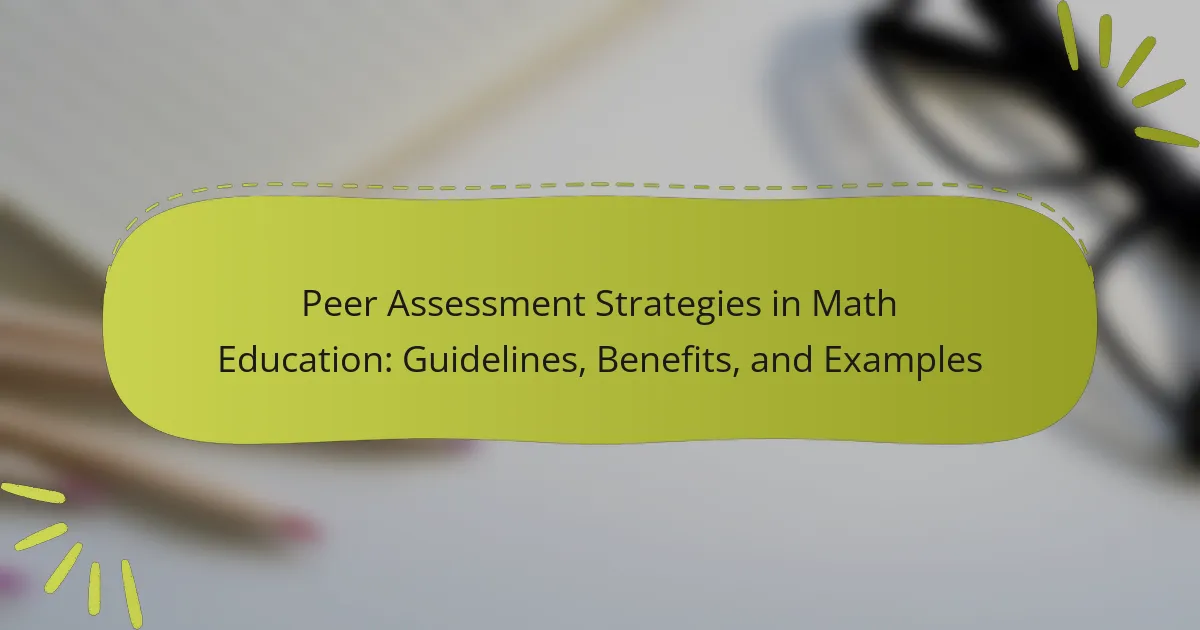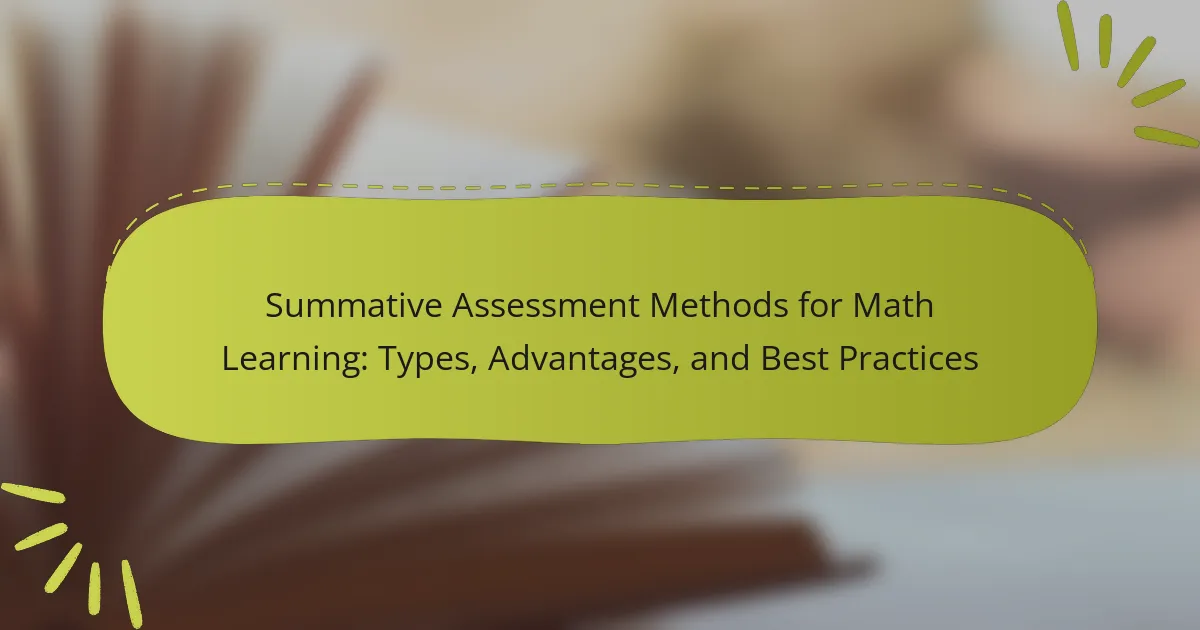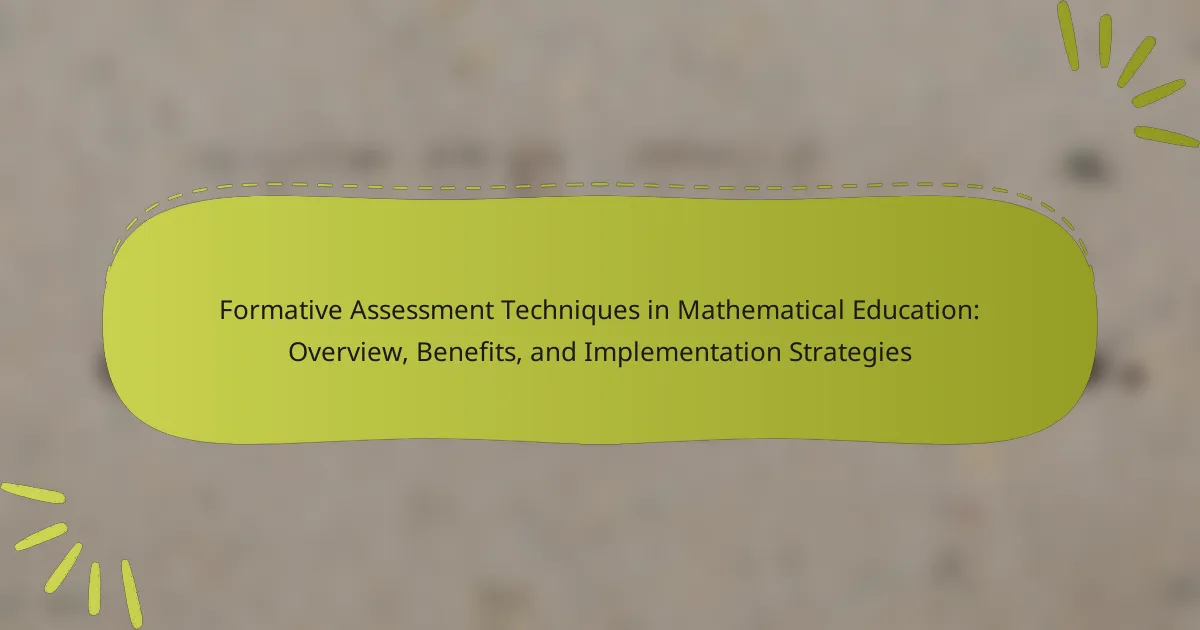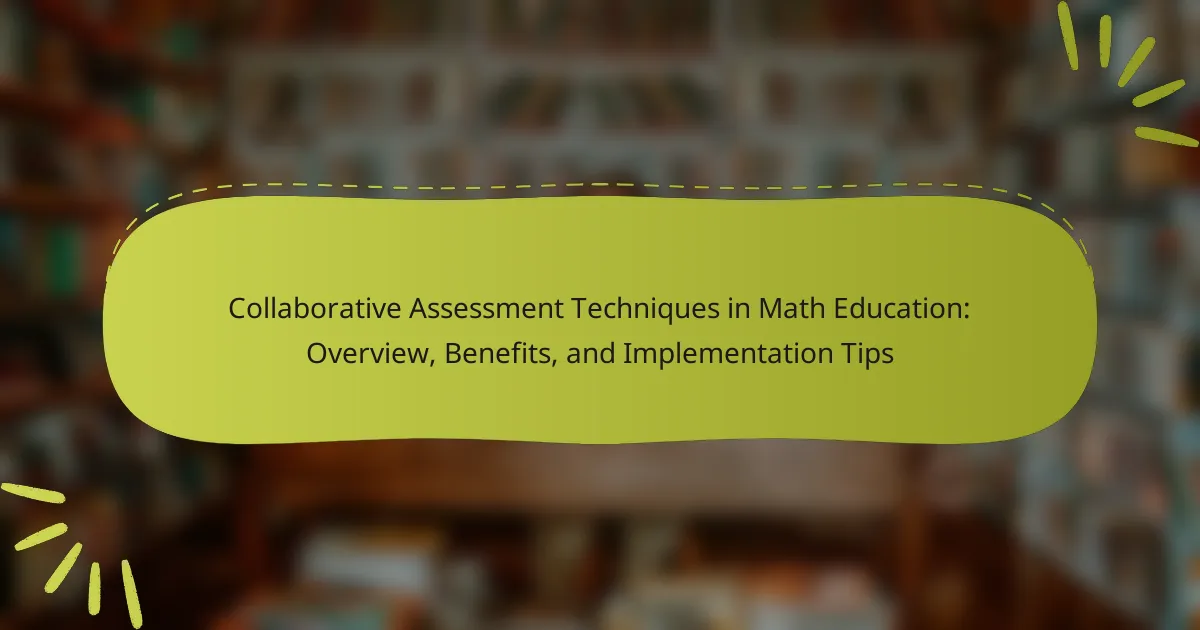Alternative assessment methods in mathematics are innovative evaluation techniques that differ from traditional testing, including portfolios, projects, and performance tasks. These methods emphasize the demonstration of understanding and application of mathematical concepts in practical contexts. Research indicates that such assessments can enhance student engagement, motivation, and learning outcomes by providing a comprehensive view of students’ abilities. The article explores various types of alternative assessments, their benefits, and practical applications, highlighting how educators can effectively implement these strategies to foster critical thinking and collaborative learning in mathematics.
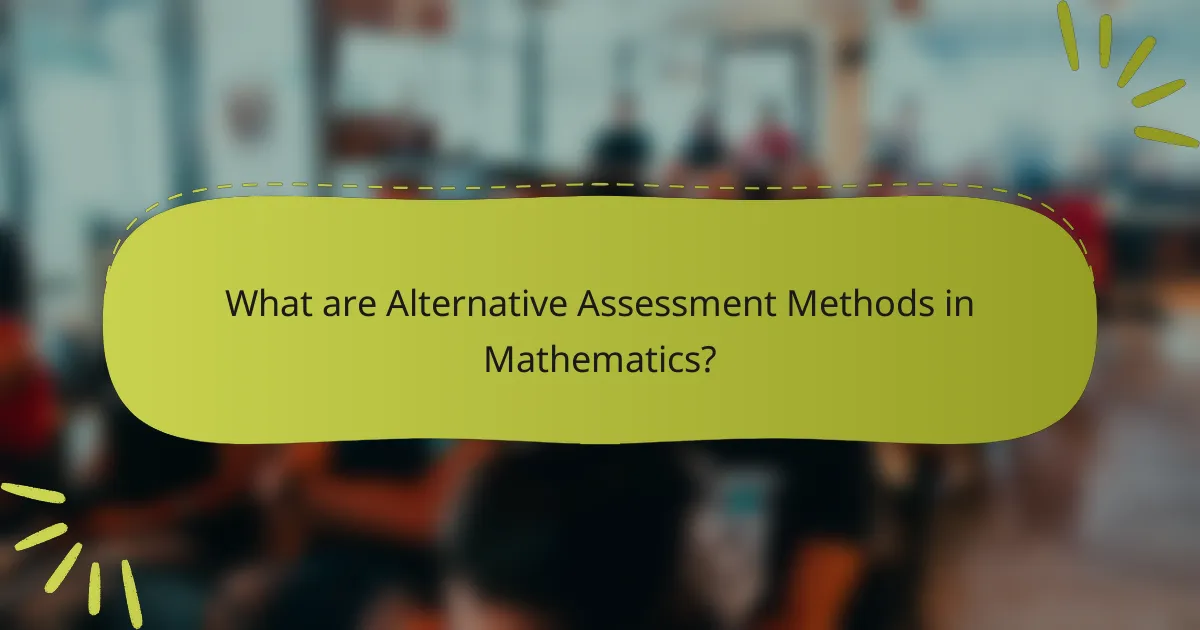
What are Alternative Assessment Methods in Mathematics?
Alternative assessment methods in mathematics are evaluation techniques that differ from traditional testing. These methods include portfolios, projects, and performance tasks. They focus on demonstrating understanding and application of mathematical concepts. Portfolios showcase a student’s work over time, reflecting their learning process. Projects often involve real-world problems, requiring critical thinking and collaboration. Performance tasks assess students’ ability to apply skills in practical situations. Research indicates these methods can enhance student engagement and provide a more comprehensive view of their abilities. Studies show that alternative assessments can lead to improved learning outcomes and foster a deeper understanding of mathematics.
How do Alternative Assessment Methods differ from Traditional Assessments?
Alternative assessment methods differ from traditional assessments primarily in their approach to evaluating student understanding. Traditional assessments typically rely on standardized tests and quizzes that measure memorization and recall. In contrast, alternative assessments focus on real-world applications and critical thinking skills.
Alternative methods include projects, portfolios, and performance tasks. These formats allow for a deeper exploration of concepts and skills. They emphasize process over product, encouraging creativity and problem-solving.
Research shows that alternative assessments can lead to improved student engagement and motivation. A study by Wiggins (1990) highlights how performance-based assessments provide a more holistic view of student abilities. This approach aligns with contemporary educational goals of fostering comprehensive skill sets.
What are the key characteristics of Alternative Assessment Methods?
Alternative assessment methods focus on evaluating student learning through diverse approaches beyond traditional testing. These methods include performance-based assessments, portfolios, and self-assessments. They emphasize critical thinking and problem-solving skills. Alternative assessments often promote collaboration among students. They provide opportunities for personalized feedback. These methods can accommodate different learning styles and needs. Research indicates that alternative assessments can enhance student engagement and motivation. Studies show improved retention of knowledge when using these methods.
Why is it important to differentiate between these assessment types?
Differentiating between assessment types is crucial for effective evaluation in mathematics. Each assessment type serves distinct educational purposes. Formative assessments provide ongoing feedback to improve learning. Summative assessments evaluate overall understanding at the end of an instructional period. Diagnostic assessments identify specific learning needs before instruction begins. Recognizing these differences allows educators to tailor their teaching strategies. This targeted approach enhances student engagement and learning outcomes. Research indicates that varied assessment methods improve student performance and understanding (Black & Wiliam, 1998). Understanding assessment types ensures that educators apply the most suitable method for their objectives.
What types of Alternative Assessment Methods are commonly used in Mathematics?
Commonly used alternative assessment methods in mathematics include portfolios, performance tasks, and projects. Portfolios allow students to showcase their work over time, demonstrating growth and understanding. Performance tasks assess students through real-world applications of mathematical concepts. Projects engage students in deeper exploration of mathematical ideas, often integrating multiple skills. Additionally, self-assessments and peer assessments encourage reflection and collaboration among students. Research shows that these methods can enhance student engagement and provide a more comprehensive understanding of their mathematical abilities.
What is the role of performance-based assessments in Mathematics?
Performance-based assessments in Mathematics evaluate students’ ability to apply mathematical concepts in real-world situations. These assessments require students to demonstrate their understanding through practical tasks. They promote critical thinking and problem-solving skills. Students engage in collaborative projects or individual tasks that reflect their learning. Research shows that performance-based assessments can improve student engagement and motivation. They provide a more comprehensive view of a student’s abilities than traditional tests. This method aligns with educational standards that emphasize application over rote memorization. Overall, performance-based assessments play a crucial role in enhancing mathematical learning and assessment.
How do project-based assessments enhance learning in Mathematics?
Project-based assessments enhance learning in Mathematics by promoting active engagement and real-world application of mathematical concepts. These assessments require students to solve complex problems, fostering critical thinking skills. Students collaborate on projects, which enhances communication and teamwork abilities. This method encourages deeper understanding as students connect mathematics to practical situations. Research indicates that project-based learning can improve retention of mathematical concepts. A study by Thomas (2000) found that students involved in project-based assessments showed higher achievement levels compared to traditional assessment methods. Overall, project-based assessments create a dynamic learning environment that supports comprehensive mathematical understanding.
What are the benefits of using portfolios in Mathematics assessments?
Using portfolios in Mathematics assessments enhances student learning and provides a comprehensive evaluation method. Portfolios allow for the collection of various student work over time. This showcases progress and understanding in mathematical concepts. They encourage self-reflection and critical thinking among students. Students can demonstrate their problem-solving processes and reasoning skills. Portfolios also promote individualized feedback from educators. This feedback can guide future learning and improvement. Research shows that portfolio assessments can lead to higher student engagement and motivation in Mathematics.
What benefits do Alternative Assessment Methods provide in Mathematics education?
Alternative assessment methods provide enhanced understanding and engagement in mathematics education. These methods allow for diverse evaluation formats, such as projects and presentations. They encourage critical thinking and problem-solving skills. Students can demonstrate their knowledge in varied ways, catering to different learning styles. This approach fosters a deeper connection to the material. Evidence shows that students often perform better when assessed through alternative methods. For instance, studies indicate that project-based assessments can lead to higher retention of mathematical concepts. Overall, alternative assessments create a more inclusive and effective learning environment in mathematics.
How do these methods support diverse learning styles?
Alternative assessment methods support diverse learning styles by accommodating various ways students process information. These methods include project-based assessments, portfolios, and performance tasks. They allow students to demonstrate understanding through visual, auditory, and kinesthetic means. For example, visual learners benefit from graphic organizers, while auditory learners excel in presentations. Kinesthetic learners engage effectively through hands-on activities. Research shows that diverse assessment methods enhance student engagement and retention. A study by Tomlinson (2001) indicates that varied approaches cater to individual strengths, leading to improved academic performance. Thus, alternative assessments create an inclusive environment for all learning styles.
What impact do Alternative Assessment Methods have on student engagement?
Alternative assessment methods significantly enhance student engagement. These methods, such as project-based learning and peer assessments, encourage active participation. Students often feel more motivated when they can demonstrate their understanding in varied ways. Research indicates that these assessments foster a sense of ownership over learning. A study by McMillan and Hearn (2008) found that students engaged in alternative assessments reported higher levels of interest and motivation. Furthermore, these methods cater to diverse learning styles, making education more inclusive. Overall, alternative assessment methods create a more dynamic and engaging learning environment.
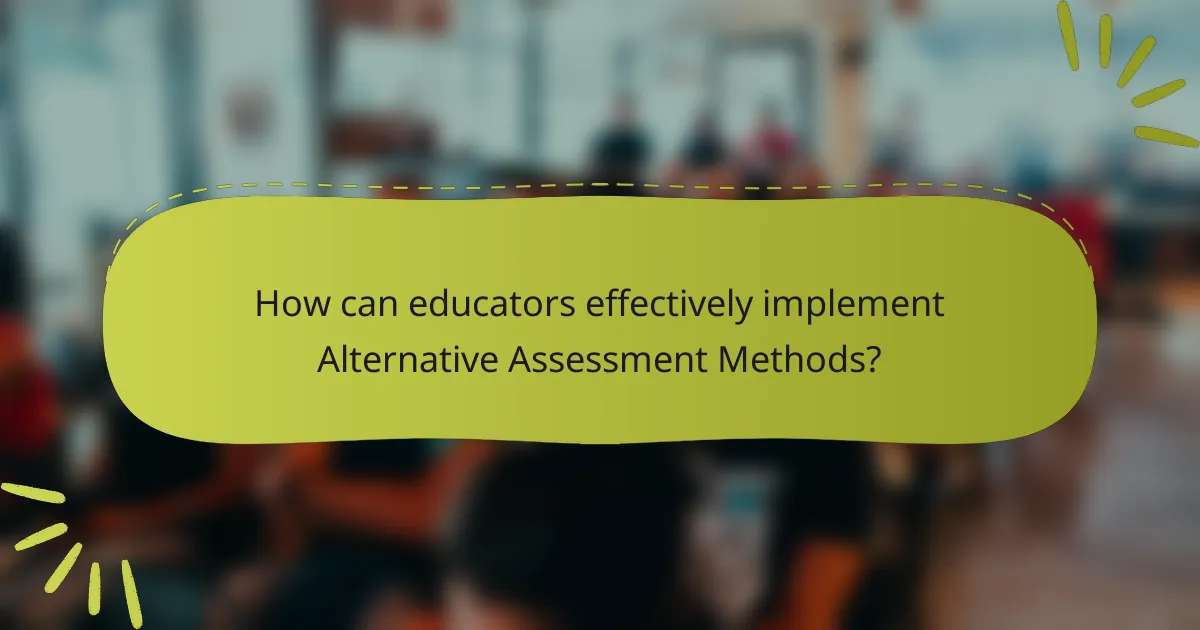
How can educators effectively implement Alternative Assessment Methods?
Educators can effectively implement Alternative Assessment Methods by integrating diverse evaluation techniques tailored to student needs. These methods include project-based assessments, portfolios, and peer assessments. Each technique encourages critical thinking and practical application of knowledge.
For instance, project-based assessments allow students to engage in real-world problems. Portfolios provide a comprehensive view of student progress over time. Peer assessments foster collaborative learning and self-reflection.
Research shows that alternative assessments can improve student engagement and motivation. A study by Wiggins (1990) emphasizes that authentic assessments promote deeper learning. Therefore, educators should adopt these methods to enhance student outcomes in mathematics.
What strategies can teachers use to integrate these methods into their curriculum?
Teachers can integrate alternative assessment methods into their curriculum by employing project-based learning. This strategy encourages students to engage in real-world problems. Teachers can design assessments that require critical thinking and collaboration. Incorporating technology is another effective strategy. Digital tools can facilitate interactive assessments. Formative assessments can be used regularly to monitor student progress. Teachers should provide feedback that guides future learning. Additionally, peer assessments can foster a collaborative learning environment. These strategies enhance student engagement and provide a comprehensive understanding of mathematical concepts.
How can assessment rubrics improve the use of Alternative Assessment Methods?
Assessment rubrics enhance the use of Alternative Assessment Methods by providing clear criteria for evaluation. They establish specific expectations for student performance. This clarity helps students understand what is required for success. Rubrics also promote consistency in grading across different assessors. They reduce subjectivity by outlining measurable standards. Research indicates that using rubrics can increase student engagement and motivation. A study by Andrade and Du (2005) found that students who used rubrics performed better in assessments. Overall, rubrics facilitate a more structured and transparent assessment process in alternative methods.
What role does student feedback play in Alternative Assessments?
Student feedback plays a crucial role in alternative assessments. It helps educators understand student perspectives and learning experiences. Feedback can identify areas where students struggle. This information allows for targeted instructional adjustments. Additionally, feedback fosters a collaborative learning environment. It encourages students to take ownership of their learning. Research shows that incorporating student feedback improves assessment effectiveness. For example, a study by Hattie and Timperley (2007) highlights the positive impact of feedback on student performance.
What challenges might educators face when using Alternative Assessment Methods?
Educators may face several challenges when using alternative assessment methods. One challenge is the lack of standardized criteria for evaluation. This can lead to inconsistencies in grading. Another challenge is the increased time required for designing and implementing these assessments. Educators may also struggle with training and resources needed for effective execution. Limited familiarity with these methods can result in resistance from both educators and students. Additionally, alternative assessments may not always align with standardized testing expectations. This misalignment can complicate curriculum planning. Lastly, educators may encounter difficulties in ensuring fairness and accessibility in assessments. These challenges can hinder the successful integration of alternative assessment methods in mathematics education.
How can teachers address potential biases in Alternative Assessments?
Teachers can address potential biases in Alternative Assessments by implementing several strategies. First, they should ensure assessments are culturally relevant and inclusive. This approach helps to minimize bias related to students’ backgrounds. Second, teachers can use a variety of assessment formats to accommodate diverse learning styles. This practice allows all students to demonstrate their understanding effectively. Third, they should involve students in the assessment design process. Engaging students can provide insights into their experiences and needs. Fourth, teachers can regularly review and reflect on assessment outcomes. Analyzing data can highlight any patterns of bias that may exist. Lastly, professional development on equity in assessment can equip teachers with the necessary tools and awareness. Research shows that these strategies can lead to fairer assessment practices and improved student outcomes.
What are common misconceptions about Alternative Assessment Methods?
Common misconceptions about alternative assessment methods include the belief that they lack rigor. Many educators think these methods are less valid than traditional assessments. However, research indicates that alternative assessments can provide a more comprehensive view of student understanding. Another misconception is that they are time-consuming. In fact, many alternative assessments can be integrated into regular classroom activities. Some also believe that alternative assessments are subjective. Yet, when designed effectively, they can include clear criteria and rubrics to ensure objectivity. Lastly, there is a notion that alternative assessments are only suitable for certain subjects. In reality, they can be applied across various disciplines, including mathematics.
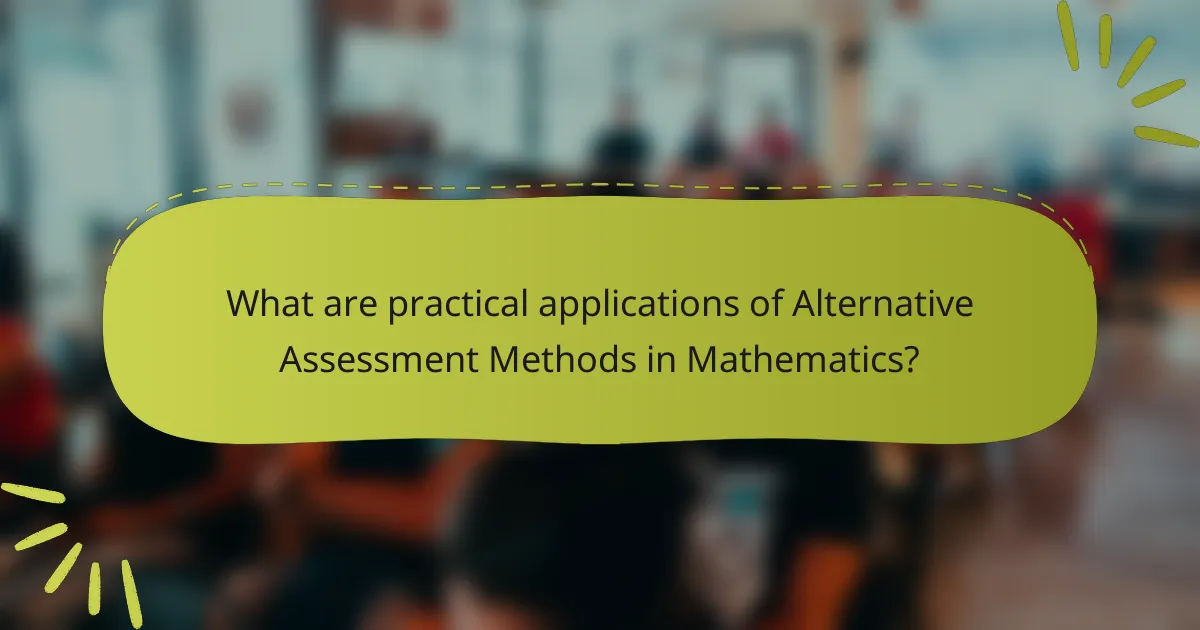
What are practical applications of Alternative Assessment Methods in Mathematics?
Alternative assessment methods in mathematics include various strategies like portfolio assessments, project-based learning, and performance tasks. These methods allow students to demonstrate their understanding in diverse ways. For instance, portfolio assessments enable students to compile their work over time, showcasing their progress and understanding. Project-based learning encourages real-world application of mathematical concepts, enhancing engagement and retention. Performance tasks require students to solve complex problems, reflecting their analytical skills. Research shows that these methods can improve student motivation and learning outcomes. A study by Wiggins (1990) emphasizes that alternative assessments can provide a more comprehensive view of a student’s abilities compared to traditional testing.
How can technology enhance Alternative Assessment Methods in Mathematics?
Technology can enhance Alternative Assessment Methods in Mathematics by providing interactive and personalized learning experiences. Digital tools allow for real-time feedback, enabling students to understand their mistakes immediately. Online platforms can facilitate collaborative problem-solving, fostering communication and teamwork among students. Adaptive learning software tailors assessments to individual skill levels, ensuring that each student is challenged appropriately. Data analytics can track student progress over time, helping educators identify trends and areas for improvement. Furthermore, technology can incorporate multimedia elements, making assessments more engaging and accessible. Research shows that technology integration in assessments leads to improved student outcomes and higher engagement levels.
What tools and platforms are available for implementing these assessments?
Tools and platforms available for implementing alternative assessments in mathematics include Google Forms, Microsoft Forms, and Kahoot. Google Forms allows educators to create customized quizzes and surveys. Microsoft Forms offers similar features with integration into the Microsoft ecosystem. Kahoot provides an interactive platform for quizzes that engage students through gamification. Other platforms include Edmodo, which supports assignment submissions and feedback, and Flipgrid, which enables video responses for assessments. These tools facilitate diverse assessment methods, enhancing student engagement and learning outcomes.
How can online assessments be effectively utilized in Mathematics education?
Online assessments can be effectively utilized in Mathematics education by providing immediate feedback to students. This instant feedback allows learners to identify their strengths and weaknesses promptly. Online assessments can also adapt to the skill level of each student, offering personalized learning experiences. They can include various question types, such as multiple-choice, short answer, and interactive problems.
Research shows that online assessments can increase student engagement. A study published in the “Journal of Educational Technology & Society” found that interactive assessments improve motivation and retention. Additionally, teachers can analyze data from online assessments to track progress over time. This data-driven approach enables targeted interventions for students who need extra help.
Utilizing online assessments also facilitates remote learning. Students can access assessments anytime and anywhere, making learning more flexible. Overall, online assessments enhance Mathematics education through immediate feedback, personalized experiences, and valuable data insights.
What are best practices for evaluating student performance using Alternative Assessments?
Best practices for evaluating student performance using alternative assessments include aligning assessments with learning objectives. This ensures that the assessment measures the desired skills and knowledge. Utilizing a variety of assessment types, such as projects, portfolios, and presentations, caters to different learning styles. Incorporating self-assessment and peer assessment encourages student reflection and engagement. Providing clear rubrics helps students understand expectations and criteria for success. Regular feedback throughout the assessment process supports student learning and improvement. Finally, involving students in the assessment design fosters ownership and motivation. Research indicates that these practices enhance the validity and reliability of alternative assessments (Stiggins, 2005).
How can educators ensure fairness and consistency in grading?
Educators can ensure fairness and consistency in grading by implementing clear criteria and rubrics. Establishing specific grading rubrics provides transparency for students. Rubrics outline expectations and reduce subjective interpretations of performance. Regularly reviewing and updating these criteria helps maintain relevance and fairness. Utilizing multiple assessment methods allows for a comprehensive evaluation of student understanding. This approach accommodates diverse learning styles and reduces bias. Additionally, peer reviews and self-assessments can promote accountability among students. Training educators on bias awareness further enhances grading fairness. Research indicates that structured grading systems lead to more equitable outcomes (Brookhart, 2013, “How to Create and Use Rubrics for Formative Assessment and Grading”).
What tips can help educators create effective Alternative Assessment tasks?
Educators can create effective Alternative Assessment tasks by ensuring clarity in objectives. Clearly defined goals guide both instruction and assessment. Incorporate diverse formats to cater to different learning styles. This includes projects, presentations, and portfolios. Use rubrics to provide transparent criteria for evaluation. Rubrics help students understand expectations and improve their work. Encourage self-assessment and peer feedback to promote reflection. This approach enhances critical thinking and ownership of learning. Lastly, align assessments with real-world applications to increase relevance. Real-world connections make learning more meaningful and engaging.
Alternative Assessment Methods in Mathematics encompass evaluation techniques such as portfolios, projects, and performance tasks that differ from traditional testing. These methods emphasize the demonstration of understanding and application of mathematical concepts, enhancing student engagement and providing a comprehensive view of their abilities. Key characteristics include a focus on critical thinking, collaboration, and personalized feedback, while addressing diverse learning styles. The article explores the differences between alternative and traditional assessments, the benefits of various methods, and practical applications for educators looking to implement these strategies effectively.
